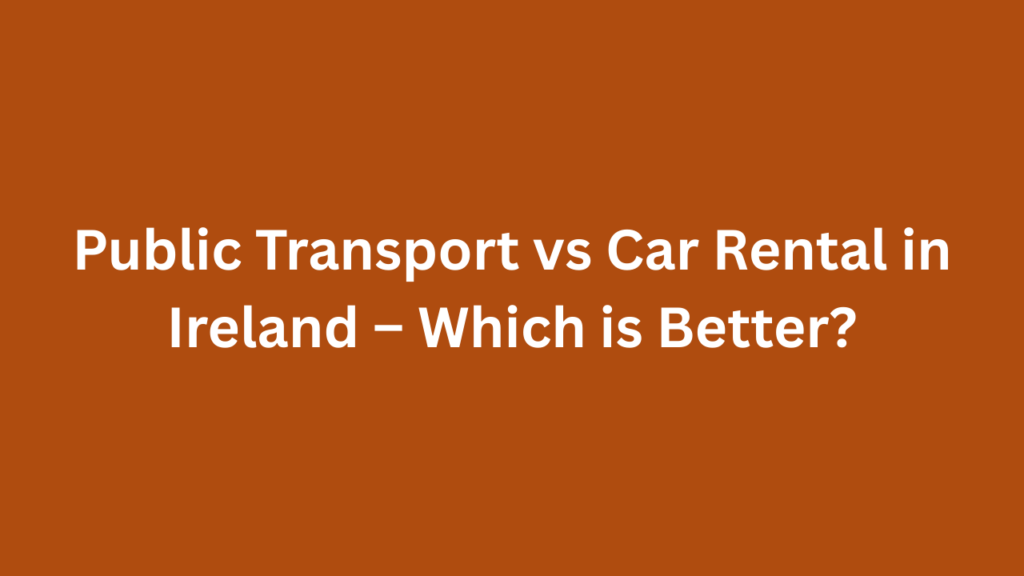When planning a trip to Ireland, one of the first questions many travelers ask is: Should I rely on public transport or rent a car? The answer isn’t one-size-fits-all—it depends on your budget, comfort level with driving, itinerary, and the kind of Irish experience you’re after.
As someone who has both traveled Ireland by train and bus and rented a car for cross-country road trips, I’ve seen the pros and cons of both firsthand. In this guide, I’ll break down everything you need to know to make the right choice for your journey.
Why This Decision Matters Today
Tourism in Ireland has grown steadily, with over 7 million visitors annually (according to Fáilte Ireland, 2023). Many travelers flock to iconic spots like the Cliffs of Moher, the Ring of Kerry, or the Wild Atlantic Way—destinations that aren’t always easy to reach without a car.
At the same time, Ireland’s public transport system is expanding, with rail and bus services connecting most major towns and cities. But rural areas often have limited schedules, which can make exploring without a car tricky.
So—what’s better? Let’s compare.
Option 1: Public Transport in Ireland
Public transport in Ireland mainly consists of trains (Iarnród Éireann), intercity buses (Bus Éireann, Expressway, private companies like Citylink & GoBus), and local buses in cities like Dublin, Cork, Galway, and Limerick.
✅ Advantages
- No driving stress: You don’t have to worry about Ireland’s left-hand driving, narrow country roads, or city parking.
- Eco-friendly: Trains and buses are more sustainable than renting a car.
- Budget-friendly: Long-distance buses can be very affordable (€10–€25 between major cities).
- Good for city breaks: Dublin, Cork, and Galway have decent bus services, so you won’t need a car if you’re staying mostly in cities.
❌ Disadvantages
- Limited rural access: Famous spots like Glendalough, Ring of Kerry viewpoints, Connemara, and much of Donegal are difficult or impossible to reach by public transport.
- Fixed schedules: Buses and trains run on set times; missing one could mean hours of waiting.
- Longer travel times: A bus from Dublin to Galway can take 2.5–3 hours, while driving yourself takes around 2 hours.
Option 2: Renting a Car in Ireland
Car rental allows maximum flexibility and is often the best way to explore Ireland’s countryside.
✅ Advantages
- Freedom to explore: Stop at hidden castles, coastal villages, or viewpoints whenever you like.
- Access remote areas: The Wild Atlantic Way (2,500 km), rural Donegal, and the Wicklow Mountains are best explored by car.
- Time-efficient: Driving can save hours compared to buses, especially for multi-stop trips.
- More family-friendly: Easier if you’re traveling with kids, luggage, or planning multiple stops.
❌ Disadvantages
- Cost: Car rental in Ireland isn’t cheap. Expect €30–€70 per day plus insurance, fuel (€1.70–€1.90 per litre), and tolls.
- Insurance headaches: Many rental companies require Collision Damage Waiver (CDW), and credit card coverage may not apply.
- Driving challenges: Narrow rural lanes, sheep crossings, roundabouts, and driving on the left can be intimidating.
- Parking fees: In Dublin and other cities, parking can be €2–€4 per hour.
Cost Comparison: Public Transport vs Car Rental
Here’s a quick overview of typical costs:
| Expense | Public Transport | Car Rental |
|---|---|---|
| Dublin → Galway | €15–€25 (bus) / €25–€35 (train) | €50–€80 fuel + €40–€70/day rental |
| Dublin → Cork | €20–€30 (bus/train) | €60–€90 fuel + rental costs |
| Ring of Kerry Tour | €30–€50 (guided bus) | €70–€100 fuel + rental costs |
| City Transport | €2–€3 per bus fare | €2–€4 per hour parking |
My Experience: Which Worked Better?
- On one trip, I relied solely on buses and trains for a week in Dublin, Galway, and Cork. It worked well, but I missed exploring Connemara’s countryside, where buses were scarce.
- On another visit, I rented a compact car at Dublin Airport and drove the Wild Atlantic Way. The freedom to stop in small villages, beaches, and lesser-known castles made the trip unforgettable. The downside? Parking in Dublin was stressful and expensive.
Best Option for Different Travelers
- City Travelers (Dublin, Cork, Galway only): Public transport is cheaper and easier.
- Nature Lovers (Cliffs of Moher, Connemara, Donegal, Kerry): Rent a car for flexibility.
- Short Trips (2–3 days): Stick with public transport or guided tours.
- Long Road Trips (7+ days): Renting a car pays off.
FAQs About Transport in Ireland
1. Is driving in Ireland safe for tourists?
Yes, but it takes adjustment. Roads are safe, but left-hand driving and narrow lanes can be challenging at first.
2. Do I need a car in Dublin?
No. Dublin has excellent buses, trams (LUAS), and taxis. Renting a car in Dublin is often more hassle than it’s worth.
3. Can I combine both?
Absolutely. Many travelers use public transport between cities and rent a car locally for day trips (e.g., Galway → Connemara, Killarney → Ring of Kerry).
Final Thoughts: Which Is Better?
The choice between public transport and car rental in Ireland depends on what kind of trip you want.
- If you’re sticking to major cities and don’t want driving stress, public transport is the way to go.
- If you want to uncover Ireland’s hidden gems, scenic drives, and rural beauty, renting a car offers unmatched freedom.
Personally, I believe the best approach is a hybrid: rely on public transport for cities, and rent a car for countryside adventures. That way, you get the best of both worlds.

Hi, I’m Tanvir, the founder and author of Explore Ireland Now. With a deep love for Ireland and its rich culture, history, and landscapes, I created this site to share everything that makes this beautiful country worth exploring. Whether you’re a local looking for hidden gems or a traveler planning your next adventure, I provide insightful guides, tips, and recommendations to help you experience Ireland to the fullest.
From stunning landscapes to vibrant cities and quaint villages, Ireland is full of wonders waiting to be discovered. Through my personal experiences and research, I aim to bring you the most up-to-date information and inspiration for your journey.
Thank you for visiting Explore Ireland Now—I hope my content helps you uncover all that this incredible country has to offer! If you have any questions or need travel advice, feel free to reach out.



